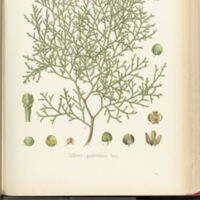Sandarac gum
Dublin Core
Title
Subject
Description
The exact botanical origin of sandarac still remains unclear. However, it is most likely that sandarac was obtained from Tetraclinis articulata, small conifers of the family Cupressaceae that grow in northwestern Africa. In the early modern period, the English, Swedish, and Hambourgeois mainly traded sandarac from Morocco, particularly the Mogador (Essaouira) port.
Until the nineteenth century, sandarac has also been described as “juniper resin” in science publications and dictionaries. Although sandarac has played an important role in medicine since the Middle Ages (and through the nineteenth century) in Europe, its most well-known use has long been for varnish.
Source
In Ms. Fr. 640, sandarac appears as "sandrax" in a recipe for producing a varnish of spike lavender oil.
Fol. 4r - “Varnish of spike lavender oil”
One needs to heat lavender spike oil & as it begins to simmer, put in powdered sandarac gum so that it soon melts. And over a charcoal fire stir continuously until the sandarac is well melted, which you will know by taking a little of the said varnish on a plate, and if it is fatty when you handle it with a finger, it is ready. And for one lb of lavender spike oil, you will put five ounces of pulverized sandarac, although some only put in four ounces, but this is neither so good nor so fatty. This one is promptly dry.
Fol. 79v - “For making varnish”
Take some mastic, sang darac, gum arabic & spike lavender oil, as much of one as the other, & make them melt all together, & before coating it, lay a coat of glue quite clear, & let it dry.
Contributor
Clara Azemard, Matthieu Ménager, and Cathy Vieillescazes, “On the Tracks of Sandarac, Review and Chemical Analysis,” Environmental Science and Pollution Research 24 (2017): 27746-27754.
L. Masschelein-Kleiner, “Sandarac,” in Ancient Binding Media, Varnishes and Adhesives, trans. Janet Bridgland, Sue Walston, and A.E. Werner, 70 (Rome: ICCROM, 1985).
“Sandarac,” The Conservation and Art Materials Encyclopedia (CAMEO), ed. Michele Derrick. http://cameo.mfa.org/wiki/Sandarac.
Image: Coloured plate of Callitris quadrivalis from Köhler's Medizinal-Pflanzen, vol. 1 (Gera-Untermhaus: Fr. Eugen Köhler, 1887). Missouri Botanical Garden, Peter H. Raven Library.
Helena Seo, Columbia University
